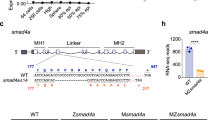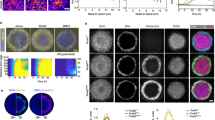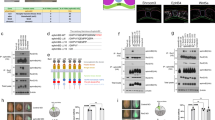Abstract
Definition of cell fates along the dorso–ventral axis depends on an antagonistic relationship between ventralizing transforming growth factor-β superfamily members, the bone morphogenetic proteins1 and factors secreted from the dorsal organizer, such as Noggin and Chordin. The extracellular binding of the last group to the bone morphogenetic proteins prevents them from activating their receptors2,3,4, and the relative ventralizer:antagonist ratio is thought to specify different dorso–ventral cell fates. Here, by taking advantage of a non-genetic interference method using a specific competitive inhibitor, the Lefty-related gene product Antivin5, we provide evidence that cell fate along the antero–posterior axis of the zebrafish embryo is controlled by the morphogenetic activity of another transforming growth factor-β superfamily subgroup—the Activin and Nodal-related factors6,7,8,9. Increasing antivin doses progressively deleted posterior fates within the ectoderm, eventually resulting in the removal of all fates except forebrain and eyes. In contrast, overexpression of activin or nodal-related factors converted ectoderm that was fated to be forebrain into more posterior ectodermal or mesendodermal fates. We propose that modulation of intercellular signalling by Antivin/Activin and Nodal-related factors provides a mechanism for the graded establishment of cell fates along the antero–posterior axis of the zebrafish embryo.
This is a preview of subscription content, access via your institution
Access options
Subscribe to this journal
Receive 51 print issues and online access
$199.00 per year
only $3.90 per issue
Buy this article
- Purchase on Springer Link
- Instant access to full article PDF
Prices may be subject to local taxes which are calculated during checkout



Similar content being viewed by others
References
Hogan, B. L. M. Bone morphogenetic proteins: multifunctional regulators of vertebrate development. Genes Dev. 10, 1580–1594 (1995).
Zimmerman, L. B., De Jesus–Escobar, J. M. & Harland, R. M. The Spemann organizer signal noggin binds and inactivates bone morphogenetic protein 4. Cell 86, 599–606 (1996).
Piccolo, S., Sasai, Y., Lu, B. & De Robertis, E. M. Dorsoventral patterning in Xenopus: inhibition of ventral signals by direct binding of chordin to BMP-4. Cell 86, 589– 598 (1996).
Sasai, Y., Lu, B., Steinbeisser, H. & De Robertis, E. M. Regulation of neural induction by the chd and Bmp-4 antagonistic patterning signals in Xenopus. Nature 376, 333– 336 (1995).
Thisse, C. & Thisse, B. Antivin, a novel and divergent member of the TGFβ superfamily regulates mesoderm induction. Development 126, 229–240 ( 1999).
Thomsen, G. et al. Activins are expressed early in Xenopus embryogenesis and can induce axial mesoderm and anterior structures. Cell 63, 485–493 (1990).
Rebagliati, M. R. et al. cyclops encodes a nodal-related factor involved in midline signaling. Proc. Natl Acad. Sci. USA 95, 9932–9937 (1998).
Sampath, K. et al. Induction of the zebrafish ventral brain and floor plate requires cyclops/nodal signalling. Nature 395, 185–189 (1998).
Feldman, B. et al. Zebrafish organizer development and germ-layer formation require nodal-related signals. Nature 395, 181– 185 (1998).
Kimmel, C. B., Warga, R. M. & Schilling T. F. Origin and organization of the zebrafish fate map. Development 108, 581–594 ( 1990).
Woo, K. & Fraser, S. C. Order and coherence in the fate map of the zebrafish nervous system. Development 121 , 2595–2609 (1995).
Green, J. B. A., New, H. J. & Smith, J. C. Responses of embryonic Xenopus cells to activin and FGF are separated by mutiple dose thresholds and correspond to distinct axes of the mesoderm. Cell 71, 731– 739 (1992).
Thisse, C. et al. goosecoid expression in neurectoderm and mesendoderm is disrupted in zebrafish cyclops gastrulas. Dev. Biol. 164, 420–429 (1994).
Melby, A. E. et al. Specification of cell fates at the dorsal margin of the zebrafish gastrula. Development 122, 2225– 2237 (1996).
Gristman, K. et al. The EGF-CFC protein one-eyed pinhead is essential for nodal signaling. Cell 97, 121– 132 (1999).
Cheng, A. M. S., Thisse, B., Thisse, C. & Wright, C. E. V. The lefty-related factor Xatv acts as a feedback inhibitor of Nodal signaling in mesoderm induction and L–R axis development in Xenopus. Development (in the press).
Woo, K. & Fraser, S. E. Specification of the zebrafish nervous system by nonaxial signals. Science 277, 254–257 (1997).
Spemann, H. Embryonic Development and Induction (Yale Univ. Press, New Haven, 1938).
Ruiz y Altaba, A. Neural expression of the Xenopus homeobox gene: Xhox3: evidence for a patterning neural signal that spreads through the ectoderm. Development 108, 595–604 (1990).
Doniach, T. et al. Planar induction of anteroposterior pattern in the developing central nervous system of Xenopus laevis. Science 257, 542–545 (1992).
Thisse, C. et al. Structure of the zebrafish snail1 gene and its expression in wild-type, spadetail, and no tail mutant embryos. Development 119, 1203–1215 (1993).
Reifers, F. et al. fgf8 is mutated in zebrafish acerebellar (ace) mutants and is required for maintenance of midbrain–hindbrain boundary development and somitogenesis. Development 125, 2381 –2395 (1998).
Oxtoby, E. & Jowett, T. Cloning of the zebrafish Krox-20 gene (Krx-20) and its expression during hindbrain development. Nucleic Acids Res. 21, 1087–1095 (1993).
Prince, V. E., Price, A. L. & Ho, R. K. Hox gene expression reveals regionalization along the anteroposterior axis of the zebrafish notochord. Development 208, 517–522 (1998).
Schulte-Merker, S. et al The protein product of the zebrafish homologue of the mouse T gene is expressed in nuclei of the germ-ring and the notochord of the early embryo. Development 116, 1021– 1023 (1992).
Krauss, S,. et al. A functionally conserved homolog of the Drosophila segment polarity gene hh is expressed in tissues with polarizing activity in zebrafish embryos. Cell 31, 1431–1444 (1993).
Acknowledgements
We thank V. Heyer and T. Steffan for technical assistance and O. Nkundwa and A. Karmim for care of fish. B.T and C.T. were supported by funds from the Institut National de la Santé et de la Recherche Médicale, the Centre National de la Recherche Scientifique, the Hôpital Universitaire de Strasbourg, the Association pour la Recherche sur le Cancer and the Ligue Nationale Contre le Cancer. C.V.E.W. was supported by a NIH grant.
Author information
Authors and Affiliations
Rights and permissions
About this article
Cite this article
Thisse, B., Wright, C. & Thisse, C. Activin- and Nodal-related factors control antero–posterior patterning of the zebrafish embryo. Nature 403, 425–428 (2000). https://doi.org/10.1038/35000200
Received:
Accepted:
Issue Date:
DOI: https://doi.org/10.1038/35000200
This article is cited by
-
Generation of extracellular morphogen gradients: the case for diffusion
Nature Reviews Genetics (2021)
-
Molecular specification of germ layers in vertebrate embryos
Cellular and Molecular Life Sciences (2016)
-
Development of Lung Epithelium from Induced Pluripotent Stem Cells
Current Transplantation Reports (2015)
-
Growth differentiation Factor 11 is an encephalic regionalizing factor in neural differentiated mouse embryonic stem cells
BMC Research Notes (2014)
-
Activin A balance regulates epithelial invasiveness and tumorigenesis
Laboratory Investigation (2014)
Comments
By submitting a comment you agree to abide by our Terms and Community Guidelines. If you find something abusive or that does not comply with our terms or guidelines please flag it as inappropriate.



